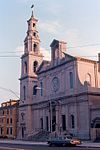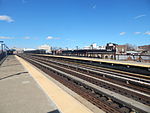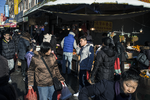St. Rosalia Church (Brooklyn)
The Church of St. Rosalia (Italian: Chiesa Cattolica Italiana Romana di St. Rosalia) was a parish church in the Borough Park neighborhood of Brooklyn, New York. The parish was founded to serve the needs of Italian Catholics in the area by the then-Bishop of Brooklyn, Charles McDonnell, in 1902. It was placed under the patronage of Saint Rosalia, the patron saint of Palermo, Italy, a region from which many of the Italian-born parishioners hailed. The founding pastor was P. Sapienza, who conducted the first Masses in a converted three-story clapboard house on 62nd Street near 13th Avenue. Within a few years, a small permanent church was constructed to serve the congregation. The parish came to be considered the "Mother Church of Italian immigrants" of the diocese.In 1923 Angelo Raffaelle Cioffi (born 1887), a native of Cervinara in the Italian Province of Avellino, who had emigrated to the United States in 1907 as a seminarian, was appointed pastor of the parish by Thomas Edmund Molloy, then Bishop of Brooklyn. He stayed in the parish until his death in 1979.In 1972, the parish obtained an organ built in 1928 by the Skinner Organ Company, which had originally served a Congregational church in Connecticut.
Excerpt from the Wikipedia article St. Rosalia Church (Brooklyn) (License: CC BY-SA 3.0, Authors).St. Rosalia Church (Brooklyn)
66th Street, New York Brooklyn
Geographical coordinates (GPS) Address Nearby Places Show on map
Geographical coordinates (GPS)
| Latitude | Longitude |
|---|---|
| N 40.626666666667 ° | E -74.003611111111 ° |
Address
Virginia Reginae School
66th Street 1221
11219 New York, Brooklyn
New York, United States
Open on Google Maps








